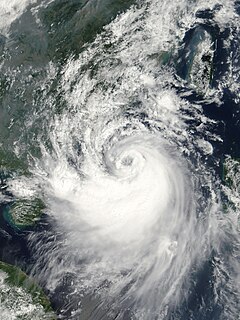The name Opal has been used for twelve tropical cyclones worldwide – one in the Atlantic Ocean and eleven in the Western Pacific Ocean.
The name Betty has been used for a total of twenty tropical cyclones worldwide: one in the Atlantic Ocean, two in the South Pacific Ocean, one in the South-West Indian Ocean, and sixteen in the Western Pacific Ocean.
The name Ellen was used for one tropical cyclone in the Atlantic Ocean.
The name Kiko has been used for a total of eleven tropical cyclones worldwide:
The name Huaning has been used for 16 tropical cyclones in the Philippine Area of Responsibility in the Northwestern Pacific Ocean.
The name Agnes has been used for a total of sixteen tropical cyclones worldwide: one in the Atlantic Ocean, thirteen in the Western North Pacific Ocean, one in the South-West Indian Ocean, and one in the South Pacific Ocean.
The name Usagi has been used to name four tropical cyclones in the northwestern Pacific Ocean. The name was contributed by Japan and is the Japanese name of the constellation Lepus.
The name Krosa has been used to name four tropical cyclones in the western north Pacific Ocean. The name was contributed by Cambodia and means crane.
The name Helen or Hellen has been used for twenty tropical cyclones worldwide: sixteen in the Western Pacific Ocean, one in the North Indian Ocean, one in the South-West Indian Ocean, and two in the Australian region.
The name Lola has been used for seventeen tropical cyclones worldwide, fifteen in the Western Pacific Ocean, one in the South Pacific Ocean, and one in the South-West Indian Ocean.
The name Louise has been used for eleven tropical cyclones worldwide, ten in the Western Pacific Ocean and one in the South-West Indian Ocean.
The name Olive has been used for a total of eleven tropical cyclones worldwide: one in the Eastern Pacific Ocean, nine in the Western Pacific Ocean, and one in the Southwest Indian Ocean.
The name Nando has been used in the Philippines by PAGASA in the Western Pacific, after Typhoon Lingling (Nanang) was retired in 2001.
The name Lando has been used for three tropical cyclones in the Philippines by PAGASA in the Western Pacific Ocean. It replaced the name Lakay.

Typhoon Koppu, known in the Philippines as Typhoon Nando was a typhoon struck China in September 2009.

Typhoon Koppu, known in the Philippines as Typhoon Lando, was a powerful and devastating tropical cyclone that struck Luzon in October 2015. It was the twenty-fourth named storm and the fifteenth typhoon of the annual typhoon season. Similar to Goni earlier in the year, Koppu originated from a tropical disturbance east of the Mariana Islands on October 10. Moving briskly west, the system consolidated into a tropical depression the following day and further into a tropical storm on October 13. Situated over the warm waters of the Philippine Sea, Koppu quickly deepened. The storm reached its peak intensity on October 17 with ten-minute sustained winds of 185 km/h (115 mph) according to the Japan Meteorological Agency (JMA). The Joint Typhoon Warning Center assessed Koppu to have been a Category 4-equivalent super typhoon with one-minute sustained winds of 240 km/h (150 mph). The storm subsequently made landfall at this strength near Casiguran, Philippines. Rapid weakening ensued due to interaction with the mountainous terrain of Luzon and the disheveled core of Koppu emerged over the South China Sea on October 19. Unfavorable environmental conditions inhibited reorganization and the system diminished to a tropical depression on October 21.
The name Pamela has been used for eleven tropical cyclones worldwide, one in the Eastern Pacific Ocean and ten in the Western Pacific.
This page is based on this
Wikipedia article Text is available under the
CC BY-SA 4.0 license; additional terms may apply.
Images, videos and audio are available under their respective licenses.

